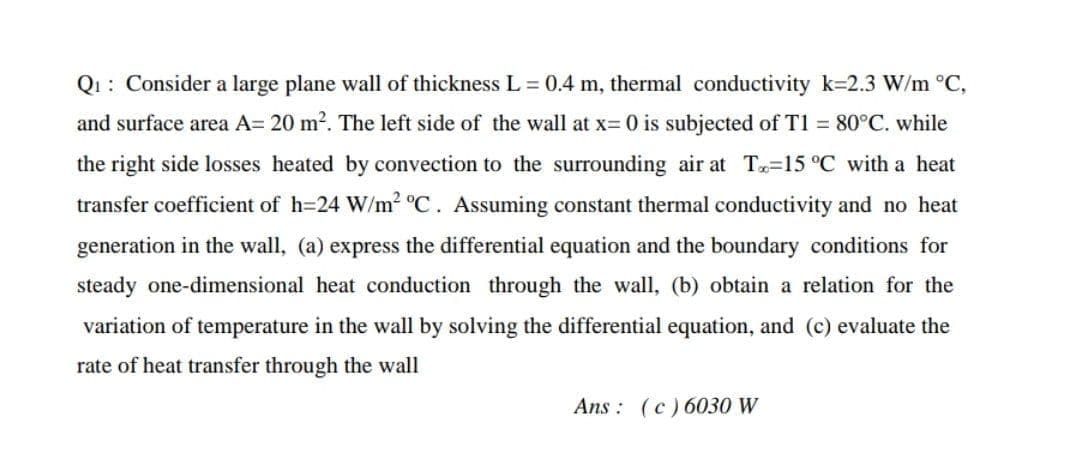Q1: Consider a large plane wall of thickness L= 0.4 m, thermal conductivity k=2.3 W/m °C, and surface area A= 20 m2. The left side of the wall at x= 0 is subjected of T1 = 80°C. while the right side losses heated by convection to the surrounding air at T-15 °C with a heat transfer coefficient of h=24 W/m2 °C. Assuming constant thermal conductivity and no heat generation in the wall, (a) express the differential equation and the boundary conditions for steady one-dimensional heat conduction through the wall, (b) obtain a relation for the variation of temperature in the wall by solving the differential equation, and (c) evaluate the rate of heat transfer through the wall
Q1: Consider a large plane wall of thickness L= 0.4 m, thermal conductivity k=2.3 W/m °C, and surface area A= 20 m2. The left side of the wall at x= 0 is subjected of T1 = 80°C. while the right side losses heated by convection to the surrounding air at T-15 °C with a heat transfer coefficient of h=24 W/m2 °C. Assuming constant thermal conductivity and no heat generation in the wall, (a) express the differential equation and the boundary conditions for steady one-dimensional heat conduction through the wall, (b) obtain a relation for the variation of temperature in the wall by solving the differential equation, and (c) evaluate the rate of heat transfer through the wall
Principles of Heat Transfer (Activate Learning with these NEW titles from Engineering!)
8th Edition
ISBN:9781305387102
Author:Kreith, Frank; Manglik, Raj M.
Publisher:Kreith, Frank; Manglik, Raj M.
Chapter8: Natural Convection
Section: Chapter Questions
Problem 8.49P
Related questions
Question

Transcribed Image Text:Q1: Consider a large plane wall of thickness L = 0.4 m, thermal conductivity k=2.3 W/m °C,
and surface area A= 20 m2. The left side of the wall at x= 0 is subjected of T1 = 80°C. while
the right side losses heated by convection to the surrounding air at T-15 °C with a heat
transfer coefficient of h=24 W/m2 C. Assuming constant thermal conductivity and no heat
generation in the wall, (a) express the differential equation and the boundary conditions for
steady one-dimensional heat conduction through the wall, (b) obtain a relation for the
variation of temperature in the wall by solving the differential equation, and (c) evaluate the
rate of heat transfer through the wall
Ans : (c) 6030 W
Expert Solution
This question has been solved!
Explore an expertly crafted, step-by-step solution for a thorough understanding of key concepts.
This is a popular solution!
Trending now
This is a popular solution!
Step by step
Solved in 4 steps with 2 images

Knowledge Booster
Learn more about
Need a deep-dive on the concept behind this application? Look no further. Learn more about this topic, mechanical-engineering and related others by exploring similar questions and additional content below.Recommended textbooks for you

Principles of Heat Transfer (Activate Learning wi…
Mechanical Engineering
ISBN:
9781305387102
Author:
Kreith, Frank; Manglik, Raj M.
Publisher:
Cengage Learning

Principles of Heat Transfer (Activate Learning wi…
Mechanical Engineering
ISBN:
9781305387102
Author:
Kreith, Frank; Manglik, Raj M.
Publisher:
Cengage Learning